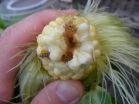Neural responses indicate our willingness to help
2010-10-08
(Press-News.org) Witnessing a person from our own group or an outsider suffer pain causes neural responses in two very different regions of the brain. And, the specific region activated reveals whether or not we will help the person in need. Researchers at the University of Zurich studied the brain responses of soccer fans and now have neurobiological evidence for why we are most willing to help members of our own group.
Our reactions to shocking news clips on television demonstrate that human beings can remain remarkably cool in the face of other peoples' suffering. And yet, we are also ready to sacrifice ourselves for others, even if no tangible reward awaits. Why such a difference? Social psychology has proven that our propensity to help is modulated by social factors. Little, however, was known about the underlying neural processes and how they are influenced by group affiliation. Now, research in neuroscience at the University of Zurich has documented that the brain regions activated when witnessing people suffer vary according to whether those suffering are perceived as group members. "And most importantly, the differences in neural responses indicate whether the observer will help the suffering person later on," as neuroscientist Grit Hein confirmed.
Grit Hein, Tania Singer (now director at the Max Planck Institute for Human Cognitive and Brain Sciences) and social psychologist C. Daniel Batson (University of Kansas, USA) measured the neural responses of soccer fans: Test subjects watched either a member of their own group (ingroup) or someone from a rival team (outgroup) be subjected to painful shocks through electrodes attached to the back of their hands. The test subjects could then decide whether or not to help an ingroup or outgroup member by receiving a portion of the pain themselves. Helping had a high cost as it was inherently linked to personal physical pain. Test persons also had the option to simply watch the other person receive the shocks or to distract themselves from the unpleasant scene by watching a soccer video.
The scientific journal Neuron has published the revealing results of the study: Should a person from an ingroup suffer pain, brain regions associated with empathy for others' pain are activated. A greater degree of activation in these regions correlates with a greater willingness to help. If, however, test subjects saw a member of an outgroup subjected to pain, brain regions motivated by reward were activated. A high degree of reward-related activation corresponds to a negative perception of the person belonging to the rival team, and the willingness to help decreases as brain activation rises.
Measuring neural responses also proves to be a more accurate prediction tool than questionnaires when trying to determine how willing people are to help people outside of their group affiliation. "After all, who is going to admit they'd help a friend in need but let an outsider suffer?" observed Grit Hein.
INFORMATION: END
ELSE PRESS RELEASES FROM THIS DATE:
2010-10-08
University of Granada researchers have developed a pioneer intervention program aimed at 3 year-old children, that helps in preventing antisocial behavior in adulthood. In its first year of implementation, the program –named Aprender a convivir– achieved that 90% of participating children interacted more actively with their peers, and that 86% reduced symptoms such as anxiety/depression, somatization, poor emotional reactivity, shyness, and social isolation.
To carry out this study –funded by the Spanish Ministry of Education and Science–, the researchers took a sample ...
2010-10-08
Researchers at Case Western Reserve University have taken the first step to building a computer capable of operating in the heat of a jet engine or the sunny side of the planet Mercury.
Te-Hao Lee, Swarup Bhunia and Mehran Mehregany, have made electromechanical switches – building blocks of circuits - that can take twice the heat that renders electronic transistors useless. Their work was published in Science last month.
The engineers took their cue from English inventor Charles Babbage, who built a steam-driven machine to calculate mathematical tables in the 1830s. ...
2010-10-08
Patient personality affects the accuracy of reports by friends and family members of mood history and symptoms and can cause missed diagnoses of depression, according to research published online by the journal International Psychogeriatrics.
Friends and family members of a person who is highly outgoing and fun-loving and who is likely to experience happiness and excitement, for example, often miss the signs that indicate the person is depressed.
"When a person who has enjoyed socializing and whose mood normally is positive becomes depressed, friends and family often ...
2010-10-08
MAYWOOD, Ill. -- A Loyola University Hospital study has demonstrated how the hospital has improved patient safety and cut costs by reducing the number of blood transfusions.
In 2009, the average amount of blood products transfused per patient at Loyola was 10 percent lower than it was in 2008, saving $453,355. The average amount of blood products transfused dropped from 2.03 units per patient in 2008 to 1.82 units per patient in 2009.
Results were reported at the recent annual meeting of the College of American Pathologists.
"We are giving the right blood component, ...
2010-10-08
Photosynthesis is the process used by plants to convert atmospheric carbon dioxide into the energy-rich chemicals upon which all life-forms depend. The energy trapped in these compounds comes from sunlight, and photosynthetic organisms – plants, algae and certain types of bacteria – capture this energy in a usable form with the help of protein complexes called photosystems. Photosystems include antenna proteins that collect incident light, and green plants have two sorts of photosystems, which respond best to light of different wavelengths. A team of researchers at LMU, ...
2010-10-08
Exposure to noise is a fact of life. At high levels, noise can damage hearing, and at lower levels it can disrupt sleep patterns, interfere with communications, and even cause accidents. A new National Academy of Engineering report characterizes the most commonly identified sources of noise, looks at efforts that have been made to reduce noise emissions, and suggests ways to decrease exposure in workplaces, schools, recreational environments, and residences.
Development of noise control technology needs immediate attention, said the committee that wrote the report. America ...
2010-10-08
###
For more information, visit NIAID's Vaccines Web site at http://www.niaid.nih.gov/topics/vaccines/Pages/Default.aspx and Biodefense Web site at http://www.niaid.nih.gov/topics/biodefenserelated/Pages/default.aspx.
NIAID conducts and supports research-at NIH, throughout the United States, and worldwide to study the causes of infectious and immune-mediated diseases, and to develop better means of preventing, diagnosing and treating these illnesses. News releases, fact sheets and other NIAID-related materials are available on the NIAID Web site at http://www.niaid.nih.gov.
The ...
2010-10-08
October 7, 2010—America continues to lag behind other nations when it comes to gains in life expectancy, and commonly cited causes for our poor performance—obesity, smoking, traffic fatalities and homicide—are not to blame, according to a study by researchers at Columbia University's Mailman School of Public Health. The study looked at health spending; behavioral risk factors like obesity and smoking; and 15-year survival rates for men and women ages 45 and 65 in the U.S. and 12 other nations -- Australia, Austria, Belgium, Canada, France, Germany, Italy, Japan, the Netherlands, ...
2010-10-08
Transgenic corn's suppression of the European corn borer has saved Midwest farmers billions of dollars in the past decade, reports a new study in Science.
Research conducted by several Midwest universities shows that suppression of this pest has saved $3.2 billion for corn growers in Illinois, Minnesota, and Wisconsin over the past 14 years with more than $2.4 billion of this total benefiting non-Bt corn growers. Comparable estimates for Iowa and Nebraska are $3.6 billion in total, with $1.9 billion accruing for non-Bt corn growers.
Transgenic corn is engineered to ...
2010-10-08
Alexandria, VA — Tinnitus is common among elderly Nigerians and associated with treatable health conditions like otitis media, rhinosinusitis, head injury and hypertension, according to new research published in the October 2010 issue of Otolaryngology – Head and Neck Surgery.
Nearly 36 million Americans, however, suffer from tinnitus or head noises. It may be an intermittent sound or an annoying continuous sound in one or both ears. In Nigeria, tinnitus affects between 10.1% and 33% of the population, with about 3 to 4% consulting a doctor on at least one occasion in ...
LAST 30 PRESS RELEASES:
[Press-News.org] Neural responses indicate our willingness to help

